Looking for the best eCommerce SEO strategy to help you grow your business?
Search engine optimization (SEO) is critical for any eCommerce business looking to drive traffic and sales from organic search. With a strategic SEO approach tailored to the unique needs of eCommerce sites, you can improve visibility, attract more qualified visitors, and ultimately boost revenue.
In this article, I’d like to share some tips to building an impactful eCommerce SEO strategy. These are proven tips that will help you drive qualified traffic, generate leads, and increase your sales.
What is an Ecommerce SEO Strategy?
An eCommerce SEO strategy is a comprehensive plan that outlines how you will optimize your online store to improve its visibility and drive more traffic and sales. It involves a combination of technical, content, and link-building strategies designed to increase your search engine rankings and attract more customers.
The Importance of Having an Ecommerce SEO Strategy
Having a well-planned eCommerce SEO strategy is vital for several reasons. Here are some of the top ones:
- Increased Visibility: A good SEO strategy helps your store appear higher in search engine results, making it more visible to potential customers.
- Targeted Traffic: By targeting specific keywords and phrases, you can attract the right audience to your store, increasing the chances of conversion.
- Competitive Advantage: A strong SEO strategy sets you apart from your competitors, giving you a competitive edge in the market.
Running an eCommerce store without an SEO strategy is a sure recipe for failure. Your target audience won’t be able to find your store and products.
However, having an eCommerce SEO strategy is a great way to help ensure your business grows.
12 Elements of an Impactful Ecommerce SEO Strategy
Ready to dive into some of the most impactful eCommerce SEO strategies you can easily employ? Let’s get right to it.
1. Use the Right Ecommerce SEO Tool
One of the first SEO tips for a successful eCommerce SEO strategy is to ensure you have the right SEO tool to help your site and product pages rank. And for WordPress users, there’s no better tool than All In One SEO (AIOSEO).
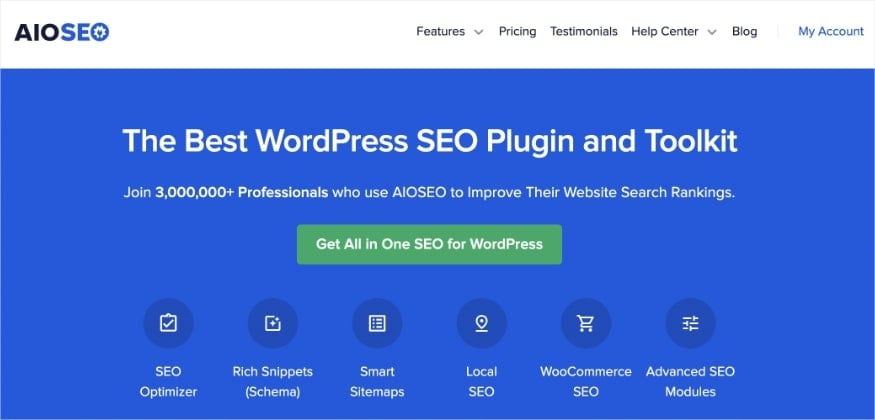
AIOSEO is a powerful yet easy-to-use SEO plugin that boasts 3+ million active installs. Millions of smart bloggers use AIOSEO to help them boost their search engine rankings and drive qualified traffic to their blogs. That’s because the plugin has many powerful features and modules designed to help you properly configure your SEO settings.
When it comes to eCommerce, some of AIOSEO’s most prominent features include:
The WooCommerce SEO Moudule
If you’re a WooCommerce user, AIOSEO has a tailor-made WooCommerce SEO module to help you rank your online store higher in search rankings. The module makes it easy for you to optimize, among other things, your:
- Product titles and meta descriptions
- Product images
- Product descriptions
Next-gen Schema Generator
Schema markup is essential to helping search engines better understand your content and products. Implementing it boosts search rankings and encourages engagement on SERPs. And doing so is super easy with AIOSEO’s next-gen Schema Generator.
Author SEO
While mainly aimed at authors, the Author SEO module helps you demonstrate Google E-E-A-T signals. This is especially important for eCommerce businesses in the YMYL (your money, your life niches) niches.
Other examples of SEO modules you’ll find in AIOSEO include:
- Search Statistics: This powerful Google Search Console integration lets you track your keyword rankings and see important SEO metrics with 1-click, and more.
- SEO Revisions: Track any changes you make to your site and see their impact on your SEO. Plus, you get to see on a timeline how Google updates affect your site.
- Keyword Rank Tracker: Monitor your position on SERPs for your most important keywords.
- Advanced Robots.txt Generator: Easily generate and customize your robots.txt file for better crawling and indexing.
For step-by-step instructions on how to install AIOSEO, check out our installation guide.
2. Build on an SEO-friendly Ecommerce Platform
Your eCommerce platform of choice can make or break your store. You need to build your store on an SEO-friendly platform. This helps you avoid common technical SEO issues and ensures your site is search engine friendly. Plus, it makes it easy for you to execute your eCommerce SEO strategy.
Examples of things to look for in an SEO-friendly eCommerce platform include customization, ease of use, lightweight, and more. One eCommerce platform that fits this bill is WooCommerce. It’s a robust platform that enables you to build any kind of eCommerce store.
However, if you don’t need a full-featured platform, you can consider WooCommerce alternatives that are tailored to specific types of online stores. A good example is Easy Digital Downloads (EDD). It’s a platform designed specifically for merchants who major in digital products.
Whether you choose WooCommerce or EDD, you’ll be glad to know that AIOSEO has features built to help those platforms have better SEO performance.
3. Conduct Proper Keyword Research
Thorough keyword research is essential for eCommerce SEO success. You need to identify the specific high-value keywords and phrases your target customers use when searching for products you sell.
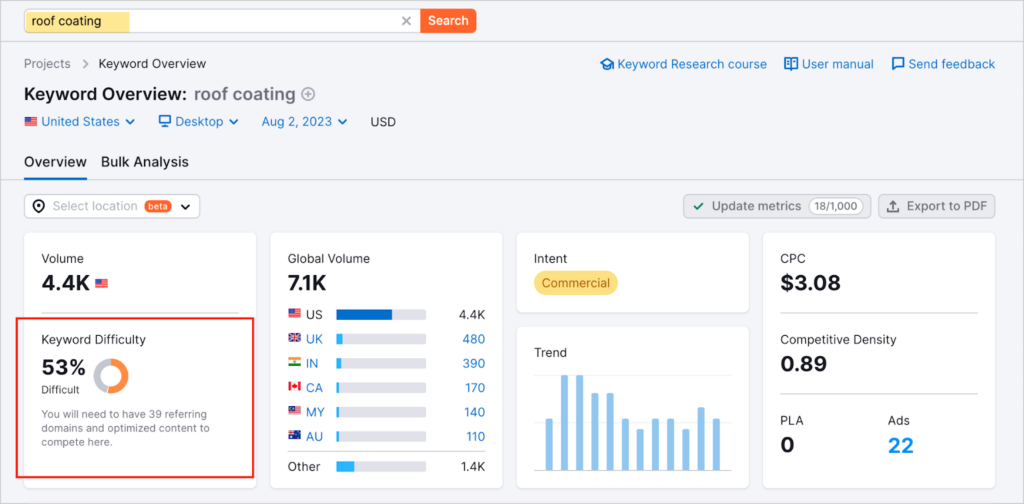

You can use various keyword research tools to help you do this, with examples being LowFruits, Semrush, Ahrefs, and more. You can use these tools to analyze metrics like keyword difficulty, search volume trends, and related terms to build out your keyword strategy.
The key to impactful eCommerce keyword research is to prioritize keywords with solid search volume and clear commercial/buyer intent over informational queries. These will help you drive organic leads that are ready to buy.
Another tip is to look at auto-suggest, and People Also Ask for semantic keywords to use in your copy.
Conducting proper keyword research is an essential aspect of running an impactful eCommerce SEO strategy. It will help you get your products and content in front of the right audience.
4. Optimize Your Product Pages
Product pages are the main money pages of any eCommerce store. That’s because they’re the pages you use to showcase your products. As such, they are an integral part of any eCommerce SEO strategy.
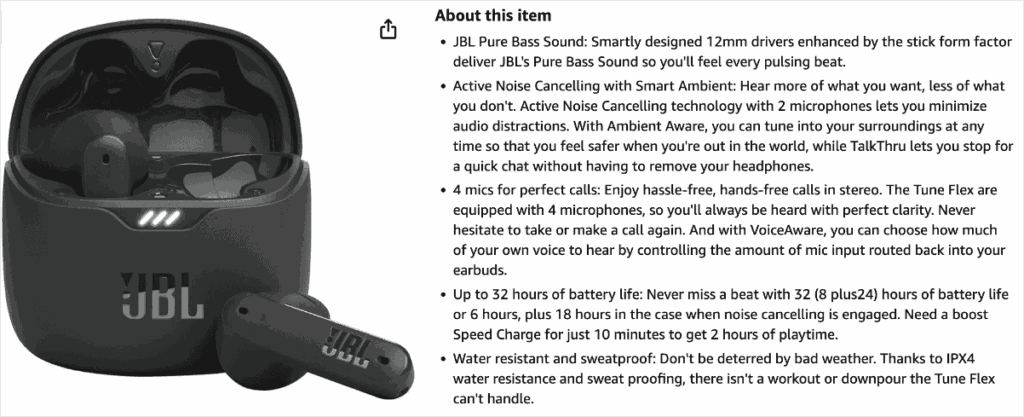

Each individual product page should be optimized comprehensively for its target keyword. Beyond the title tag and meta description, ensure the focus keyword is worked naturally into the:
Besides proper keyword research and usage, your eCommerce SEO strategy also hinges on good copywriting. Make sure all your copy is clear, concise, and helpful. This is especially true after Google’s Helpful Content Update (HCU). This means you should avoid:
- Spammy and clickbaity product descriptions
- Keyword stuffing
- Thin content
Instead, focus on ensuring every word on your eCommerce site adds value to the customer experience (CX) of your store.
5. Ensure Your Site is Mobile Responsive
Mobile internet traffic accounts for 59% of all web traffic. This means mobile SEO is an absolute must for impactful eCommerce SEO. This means creating a mobile-optimized experience for your customers. Some non-negotiable aspects of mobile SEO include:
- A responsive design that adjusts seamlessly across devices
- Fast page load speeds, a critical ranking factor
- Easy to read content without excessive pinching/zooming
- Seamless navigation and browsing experience
- Click-to-call functionality and mobile conversion optimization
For detailed information on this important part of your eCommerce SEO strategy, check out our mobile SEO guide.
6. Keep Navigation Simple
Your site structure and navigation profoundly impact your store’s SEO and usability. That’s why it must be kept simple and easy to understand.
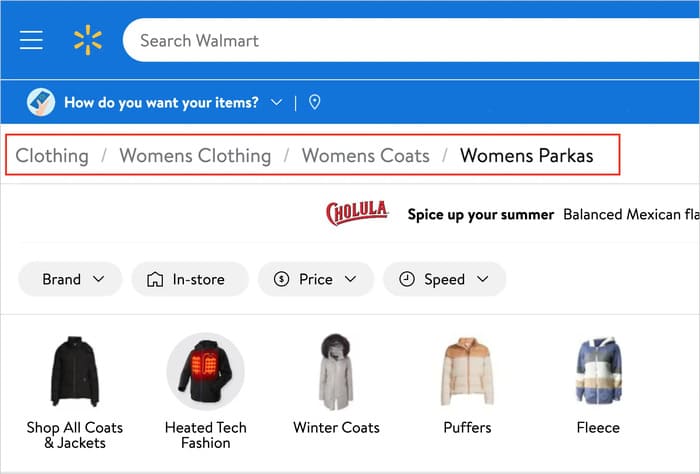

To do this, your products, categories, and subcategories should be organized in a logical structure that influences SEO and positive user experience (UX). Some elements to help you achieve this include:
- Simple, hierarchical category/subcategory navigation
- Descriptive page titles for category/product type pages
- Breadcrumb navigation to aid user pathways
- Flat, search engine-crawlable navigation
- Minimized clicks needed to reach any product
- Links to popular categories/products in the main navigation
- No excessive URL parameters or session IDs in links
- Logical product filters/faceted navigation when needed
- Internal links to top products/categories sitewide
A simple, intuitive navigation that helps both search engines and humans efficiently find what they need is ideal. It boosts your SEO and helps improve conversion rates once visitors are on your site.
7. Build Relevant Links
Because links are the backbone of the internet, they play a big role in SEO, moreso in an eCommerce SEO strategy. The 2 most important link types you should build on your online store are:
Internal links
These are links you build between pages on your site, especially pointing to your money pages. Internal links have many SEO benefits, some of which include:
Building strategic internal links is a breeze with AIOSEO’s Link Assistant. You don’t even have to manually add them.
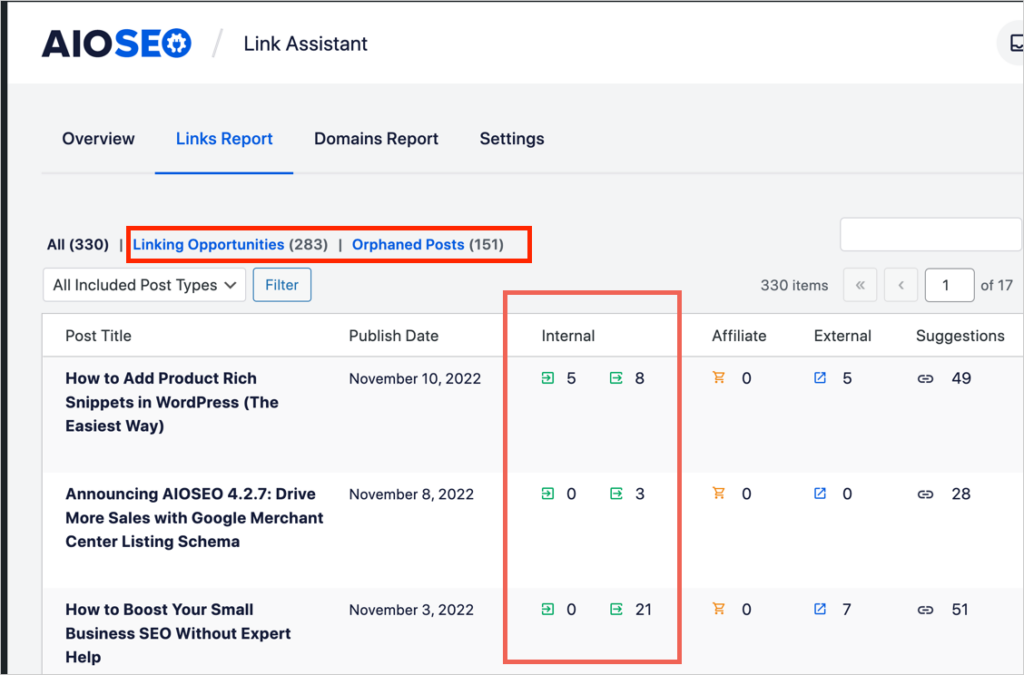

Not only does Link Assistant give you this vital data, but it helps you automatically build links between your pages. This is particularly useful for dealing with orphan pages.
Backlinks
Backlinks are links from external sites to your site. Search engines and users regard them as a vote of confidence in your site and content. This is why building backlinks should be a top priority in your eCommerce SEO strategy. A few ways of building backlinks include:
Check out our link building guide for tips on building backlinks and external links.
8. Factor In Conversion Rate Optimization (CRO)
Getting search traffic is one thing, but converting those visitors into buyers is what really counts. And that’s why conversion rate optimization (CRO) should feature prominently in your eCommerce SEO strategy. While SEO’s role is getting potential customers to your store, conversion rate optimization helps seal the deal and turn those visitors into paying customers.
Conversion rate optimization (CRO) is the science of increasing the percentage of site visitors who take a desired action. Those actions, also called conversions, can vary depending on your business goals. Examples include purchasing a product, signing up for your newsletter, sharing your content, etc. Some CRO tactics include:
- Clear, prominent calls-to-action on product pages
- Exit-intent pop-ups/overlays to prevent abandonment
- Progress indicators and urgency messaging in funnels
- A/B testing of key conversion elements
- One-click purchasing and guest checkout options
- Retargeting for visitors that don’t convert initially
Tools that can help you nail this aspect of your eCommerce SEO strategy include OptinMonster, TrustPulse, and others.
9. Use Schema Markup to Boost Engagement
Schema markup, also called structured data, is a semantic language used by search engines to better understand the content on a web page. Implemented well, it helps you qualify for rich results on SERPs.
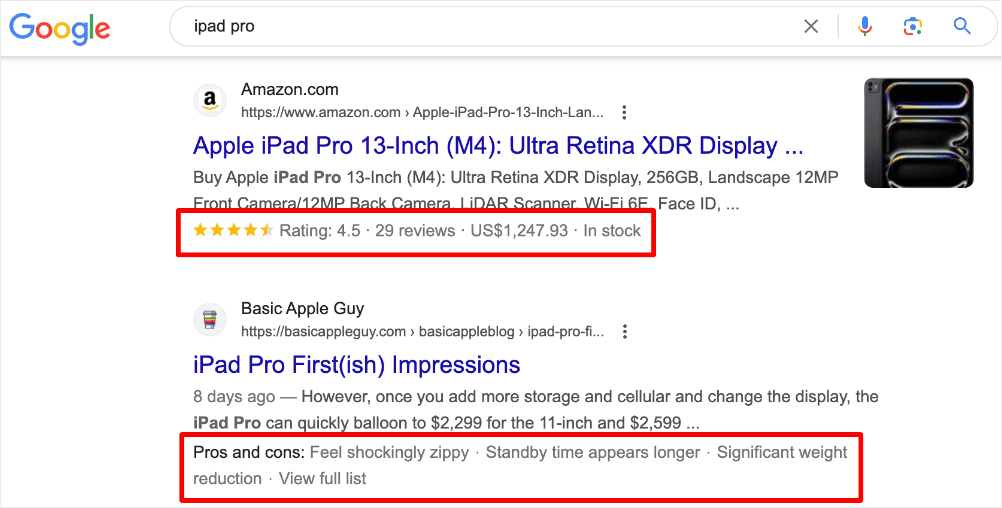

Examples include product carousels, FAQ sections, reviews, and more. These visually-enhanced listings increase your organic clickthrough rates compared to standard blue links. Some schema types that can help boost eCommerce engagement rates on SERPs include:
For more details, check out our guide on the top schema types for eCommerce.
10. Drive Traffic and Sales with Push Notifications
Push notifications open up another engagement channel for driving eCommerce traffic and sales. You can use them to re-engage past visitors with personalized notifications showcasing different marketing messages. Examples include;
- Personalized product recommendations
- Cart abandonment reminders and recovery tactics
- Promotional offers, deals, and product launch announcements
- Back-in-stock alerts for popular/sold-out items
- General engagement and brand awareness messaging
Creating push notification campaigns is super easy with a tool like PushEngage.
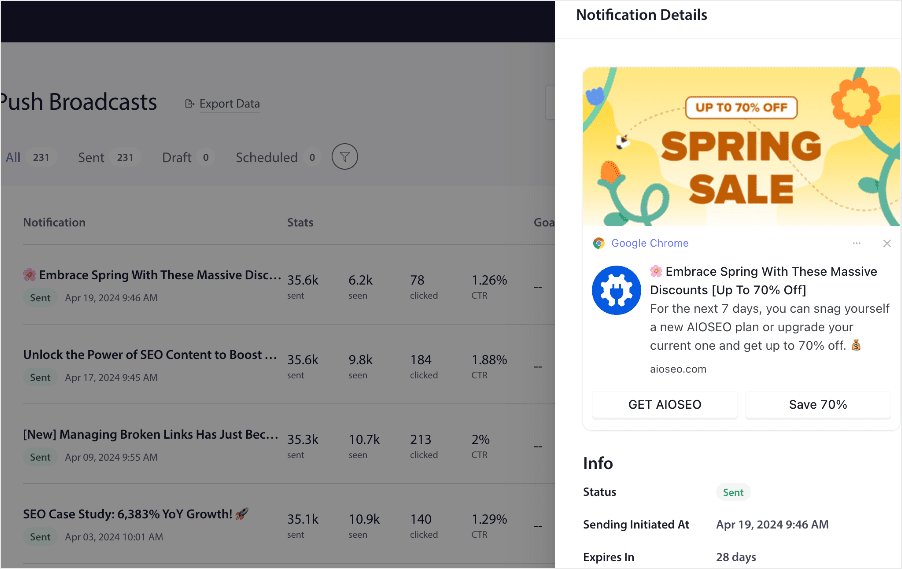

PushEngage is a no-code platform that makes it easy for users to create and send push notifications to their subscribers. The biggest advantage is that a strategic push notification cadence keeps your brand and offerings top-of-mind long after the initial session.
For tips on driving sales using this method, check out this guide on using push notifications to 10X your eCommerce profits.
11. Generate Content Faster with AI
AI writing tools offer a way to efficiently generate large volumes of unique, on-brand content to support your eCommerce SEO strategy. These tools can assist with many types of eCommerce content, including:
- Product descriptions
- Category pages
- Blog posts
- Paid ad copy
If you sell many products, AI is an invaluable resource as you can easily create or optimize existing product descriptions at scale. With AIOSEO’s AI Title/Description Generator, you can easily craft SEO titles and meta descriptions fast and effortlessly.
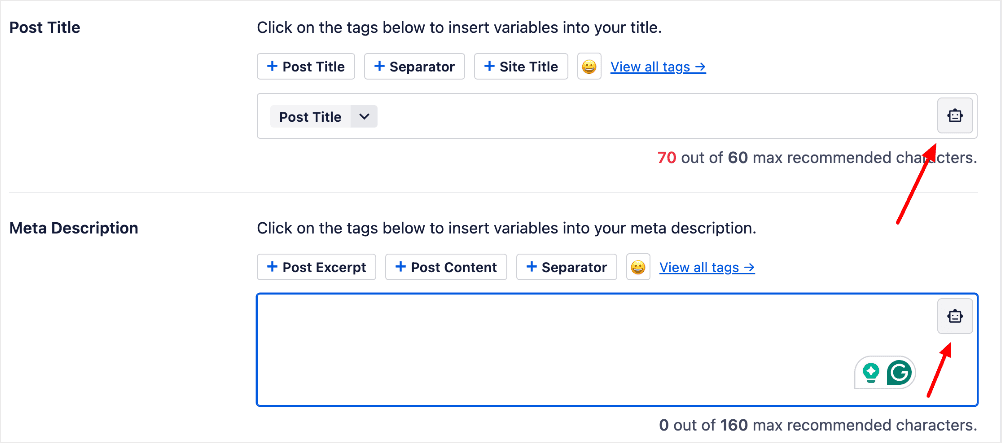

You can also leverage OptinMonster’s AI-powered popup builder. This revolutionary tool can help you create conversion-focused popups in no time.
As you can see, AI tools are invaluable to running eCommerce SEO strategies at scale. For more tools, check out our list of the best AI SEO tools.
12. Leverage Social Proof
Social proof is a fantastic way to gain your visitors’ trust and purchase confidence. That’s because people trust products recommended by other people. That is why you should prominently showcase social proof signals across your eCommerce site. Examples include displaying
- Customer ratings
- Reviews
- Testimonials
You can also display other trust signals like purchase notifications.
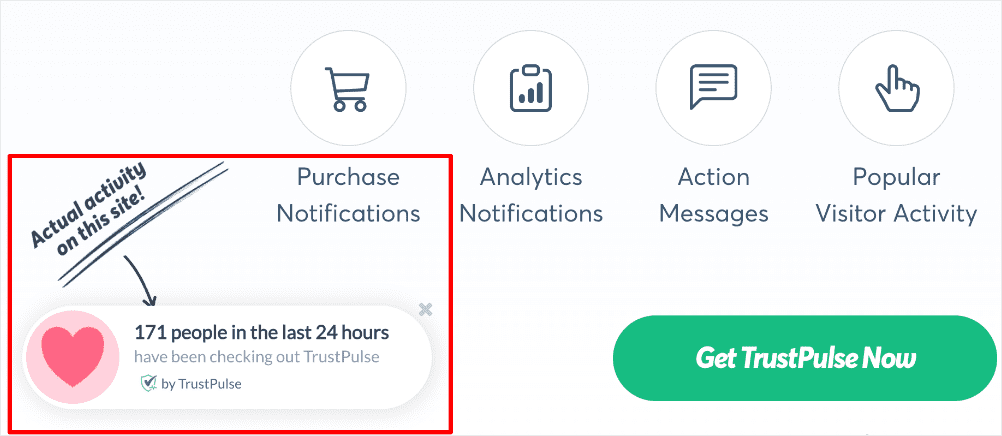

Social proof elements make your products feel more endorsed and trustworthy, ultimately encouraging more conversions from the search traffic you’re driving through SEO. The best part is they’re easy to implement with tools like TrustPulse.
Ecommerce SEO Strategy: Your FAQs Answered
What is an Ecommerce SEO strategy?
An eCommerce SEO strategy is a plan for optimizing your online store to improve its search engine rankings, drive more traffic, and increase sales. It includes technical, content, and link-building strategies.
Why do I need an Ecommerce SEO strategy?
A well-defined eCommerce SEO strategy helps you attract more targeted traffic, improve user experience, and increase conversions, ultimately driving more sales and growth for your online store.
How often should I update my Ecommerce SEO strategy?
SEO is an ongoing process. Regularly update your strategy based on performance metrics, industry trends, and search engine algorithm updates to ensure continued success.
We hope this post helped you discover the best eCommerce strategy to take your business to the next level. You may also want to check out other articles on our blog, like our WordPress SEO tips for beginners and our list of the best WooCommerce plugins.
If you found this article helpful, then please subscribe to our YouTube Channel. You’ll find many more helpful tutorials there. You can also follow us on X (Twitter), LinkedIn, or Facebook to stay in the loop.
Disclosure: Our content is reader-supported. This means if you click on some of our links, then we may earn a commission. We only recommend products that we believe will add value to our readers.


